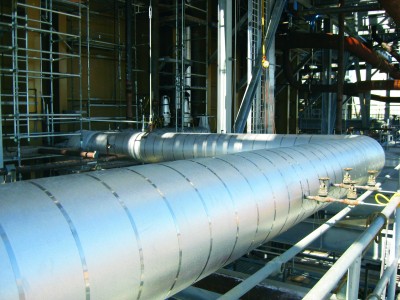With proven performance over the past 40 years, today’s industrial insulation product offering is still dominated by traditional pre-formed geometries that cover a broad range of characteristics including thermal performance, compressive strength, moisture resistance, and fire-rated properties. The most popular forms of these traditional insulation materials include calcium silicate, perlite, and mineral wool. In most cases, these insulation products offer easy installation and at least one can be used to satisfy the specific requirements of a given job across the full range of industrial applications.
These traditional insulation products have stood the test of time, and have demonstrated their performance in cost effective systems both from the standpoint of the material itself as well as the labor required for installation. The pre-formed insulations are easy to handle due to their rigidity and ease of fabrication. They also meet all necessary industrial product performance requirements including anti-corrosion properties.

That being said, in some niche applications, a thinner, more flexible insulation material may be desired due to space limitations on the job site. These applications may include piping located in tight quarters or in instances where a retrofit is required in a limited work-space environment. These jobs may require the use of a newer thin and flexible product where a thicker pre-formed product does not fit. To address these niche applications, there are thin blanket insulation products that are now available for use in high-temperature industrial applications.
Two thin and flexible high-temperature insulation products now available on the market include microporous blankets and aerogel-based blankets. These blankets have extremely low thermal conductivities, thus making it possible to significantly reduce the insulation thickness compared to traditional pre-formed insulation materials.
However, the high thermal performance of both microporous and aerogel-based blankets comes with additional costs. The blankets themselves are more expensive, and since the flat blanket sheets must be fabricated to the specified size in the field or in a fabrication shop, the installation is typically more expensive too.
Microporous and aerogel-based blankets have a hydrophobic component and repel water up to 600°F (315.5°C). At higher temperatures, the hydrophobic component oxidizes and the blankets’ water repellency properties are diminished .
An alternative to using microporous or aerogel-based blankets by themselves is to layer the new blanket product under traditional calcium silicate, perlite or mineral wool. Using a hybrid combination of the blanket and pre-formed insulations offers a number of advantages including lower cost, higher compressive resistance, and better fire-rating properties while still achieving a thinner insulation profile.
For convenience, microporous blankets and pre-formed insulation hybrids can be sourced from a single manufacturer, distributor, or fabricator. And installation guides and design tables are available to assist engineers in specifying the appropriate hybrid combinations depending on process temperature, pipe sizes, and ‘safe-to-touch’ temperature.
The current landscape of industrial insulation is changing. The thinner and flexible insulation blankets now accompany the proven traditional pre-formed insulations of the past 40 years. With the new product addition, it is wise to study all the available options in order to optimize performance and cost.
A quest for the most efficient solution may lead to installing traditional pre-formed or new blanket insulations on their own — or in a hybrid combination. Either way, the IIG technical staff has the knowledge and experience to ensure you choose the optimal solution for your application.
